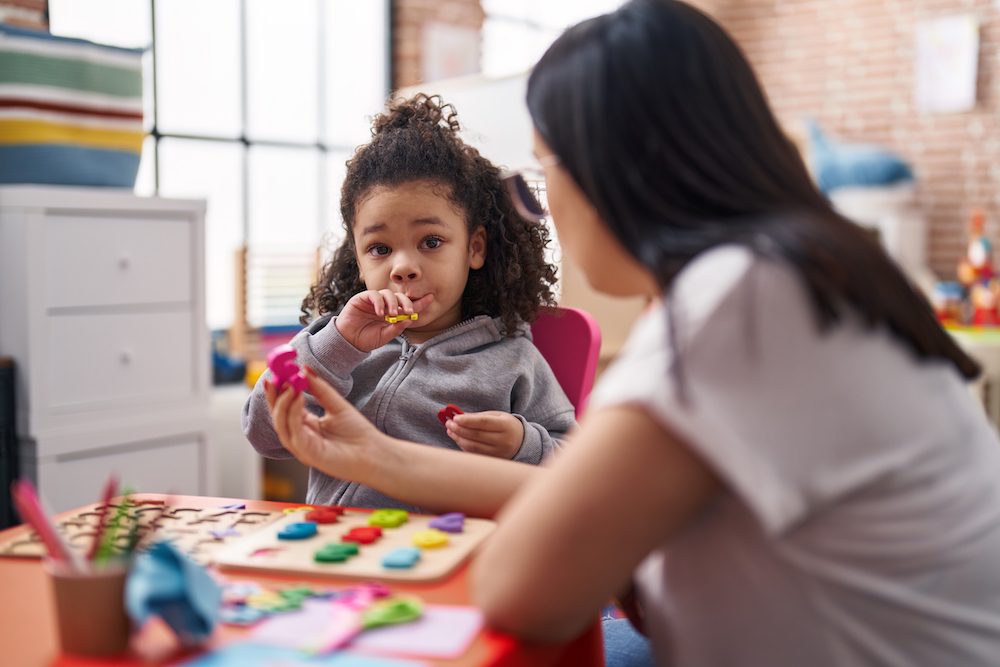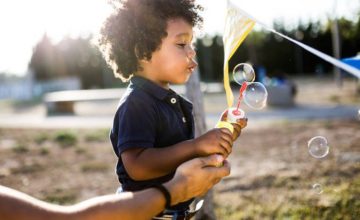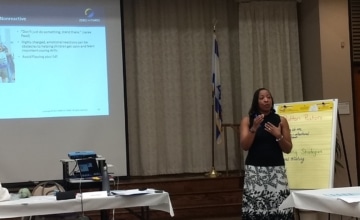Just as with language, income-based differences emerge early when it comes to math skills. Research has found a “math gap” between children from low-income families and their wealthier peers at school entry.
by Rebecca Parlakian, Senior Director of Programs, ZERO TO THREE
I’ve attended several meetings recently on the importance of early STEM skills in preschool children, but it’s a little harder to imagine what these experiences might look like for children in the first 3 years of life. Here at ZERO TO THREE we’ve been thinking about that quite a bit and exploring the ways in which early childhood professionals can provide meaningful STEM experiences to young children that honor their development and spark their curiosity. You can check out our suite of STEM resources to learn more. To focus on math specifically, check out Let’s Talk About Math.
Just as with language, income-based differences emerge early when it comes to math skills. Research has found a “math gap” between children from low-income families and their wealthier peers at school entry. At the same time, longitudinal research has reinforced the important role that early math skills play in later learning. A longitudinal study that looked at children from preschool through school-age found that children’s understanding of math concepts at school entry were the strongest predictors of overall achievement—even stronger than literacy skills. In addition, early math skills in kindergarten predicted later math and reading skills in fifth grade. So we know that math should be an important part of the early years…but what does that really mean?
In this piece, I’m going to take a moment to reflect on the use of math language with infants and toddlers. Building a child’s early math vocabulary lays the foundation for later math skills. Some early research has found that the more that young toddlers were exposed to early mathematical language by their parents, the better their spatial skills and understanding of cardinality were in preschool. So we know that language helps to build early math understanding. Here are some ideas for how to think about using this vocabulary intentionally with young children.
To build number concepts and an understanding of quantities:
- Point and count how many eyes the stuffed dog has or how many legs the caterpillar puppet has
- Count the steps up to the diaper table and down again
- Observe which pile of goldfish crackers has more or less
- When giving children shaving cream to touch during sensory play, ask if they want a lot or a little
To build an understanding of operations (early addition and subtraction), observe the changing relationships between quantities:
- Look, you have 1, 2, 3 blocks. I have 1, 2 blocks. Watch: I will take one more block and then I will have 1, 2, 3 blocks, just like you!
- You ate 2 of your banana slices. Now you have 1, 2 banana slices left.
- Kate shared a train with you. She gave you 1 train and now she has 3 trains left.
To nurture shape and spatial awareness, try talking about:
- The shapes that children encounter each day: Let’s look up—do you see any squares on the ceiling? Yes, the tiles are squares.
- The relationship between objects: The car is right next to the house. I see you put the stuffed bunny inside the box. Try turning it around—the button is on the back.
- Direction and movement trends: When you rolled the ball, it went straight down the ramp. We are going to turn right down the hall because we are walking to Ms. Amy’s office.
To help young children notice patterns, including the patterns of daily life and the patterns children can create and observe in the world around them, narrate:
- First we changed your diaper, now we are getting your bottle. Then it will be naptime.
- Let’s do a classroom dance: Clap, stomp, clap, stomp, clap, stomp. Can you try it too?
- The garbage truck comes into the parking lot. Then it backs up. Then it grabs the dumpster. Then it dumps the garbage in. Then the truck drives away!
To raise awareness of measurement concepts such as length, weight, height, speed, and temperature, use vocabulary like:
- Look how BIG that dog is. And the other dog is so SMALL!
- When you pushed the car down the slide, it went so FAST.
- Today is HOT. Today the sun is out and we are wearing shorts and t-shirts. It is hot, sunny weather so we will put sun block on before we play outside.
Many adults—me included—don’t always feel the most confident about their math abilities. But the strategy of using rich math language—observing, narrating, and labelling what you are seeing and experiencing with young children—builds on what you are already doing with them. By layering math language on the interactions you already share, you are helping babies and toddlers establish a foundation of early numeracy knowledge that they’ll use now and when they arrive in school.





